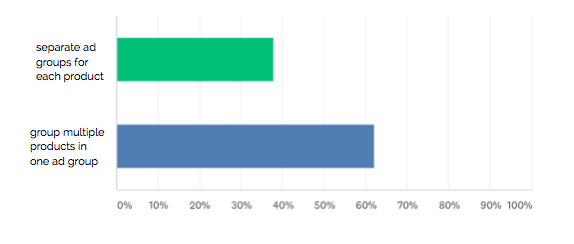Shopping KPI Survey: Campaign Organization—How do you organize your ad groups?
The Search Monitor recently conducted a survey to aggregate performance metrics for shopping campaigns on Google, Bing and Amazon.
Shopping engines don’t publish any directional stats, and few research papers have been published on this topic. Therefore, benchmarking and goal setting for shopping campaigns is challenging. That’s why we took on the task of anonymously aggregating the top most requested KPI’s, including CTR, Conversion Rate, and ROAS for advertisers running shopping campaigns on Google, Amazon and Bing.
Question
How do you organize your ad groups?

Highlights
When setting up shopping campaigns, there are two different strategies advertisers can employ depending on campaign goals—using separate ad groups for each product, or grouping multiple products together.
- Single Product Ad Group (SPAG): This strategy is similar to the Single Keyword Ad Group (SKAG) strategy in PPC campaigns. The purpose of SPAG is to manage CPCs to specific products, and identify negative keywords for specific products (rather than the entire data feed). This allows for more effective optimization.
- SPAGs make it easy for you to know which of your products are triggering what searches, and how much money your individual products are making.
- SPAGs can help ensure your campaigns are getting relevant traffic, that your bidding is in-line with an item’s revenue, and that you’re focused on products that make money.
Which strategy is right for you?
SPAG are best for data feeds with less than 100 products. As your feed expands, it can become hard to manage with a SPAG strategy.
If you manage thousands of SKUs, you want to identify top performers and keeping high-spending products with low returns from skewing your budget and lowering your ROAS and conversion rates. You can do this by separating top performing products into their own campaign with their own strategy and budget.
Download the Report







 Brand Protection
Brand Protection SEM Insights
SEM Insights Affiliate Compliance
Affiliate Compliance Ad Armor
Ad Armor Learning Center
Learning Center Guides & Webinars
Guides & Webinars We Love Data™
We Love Data™ About Us
About Us Our Data
Our Data Careers
Careers Our Team
Our Team News
News Contact Us
Contact Us

